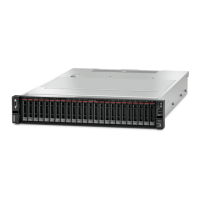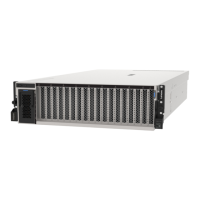After PMEMs are reconfigured, error messages and LEDs persist to indicate PMEMs are installed in
wrong slots
AC the system or restart XCC to solve this problem.
Cannot create goal successfully when installing PMEMs to the system for the first time
When seeing ones of the following messages:
• ERROR: Cannot retrieve memory resources info
• ERROR: One or more PMEM modules do not have PCD data. A platform reboot is recommended to
restore valid PCD data.
Complete the following steps to solve the problem.
1. If the PMEMs have been installed in another system with stored data, perform the following steps to
erase the data.
a. Based on the original population order, install the PMEMs to the original system where they were
installed previously, and back up the data from the PMEMs to other storage devices.
b. Disable PMEM security with one of the following options:
• LXPM
Go to UEFI Setup ➙ System Settings ➙ Intel Optane PMEMs ➙ Security ➙ Press to Disable
Security, and input passphrase to disable security.
• Setup Utility
Go to System Configuration and Boot Management ➙ System Settings ➙ Intel Optane
PMEMs ➙ Security ➙ Press to Disable Security, and input passphrase to disable security.
c. Delete namespaces with command corresponding to the operating system that is installed:
• Linux command:
ndctl destroy-namespace all -f
• Windows Powershell command
Get-PmemDisk | Remove-PmemDisk
d. Clear Platform Configuration Data (PCD) and Namespace Label Storage Area (LSA) with the following
ipmctl command (for both Linux and Windows).
ipmctl delete -pcd
Notes: See the following links to learn how to download and use impctl in different operating
systems:
• Windows: https://datacentersupport.lenovo.com/us/en/videos/YTV101407
• Linux: https://datacentersupport.lenovo.com/us/en/solutions/HT508642
2. Install the PMEMs back to the target system., and upgrade system firmware to the latest version without
entering Setup Utility.
3. If the problem persists, overwrite PMEMs with the following ndctl command.
ndctl sanitize-dimm --overwrite all
4. Monitor the overwrite status with the following command.
watch -n 1 “ipmctl show -d OverwriteStatus -dimm”
5. When seeing all PMEM OverwriteStatus=Completed, reboot the system and see if the problem persists.
Hard disk drive problems
Use this information to resolve issues related to the hard disk drives.
Chapter 5. Problem determination 395

